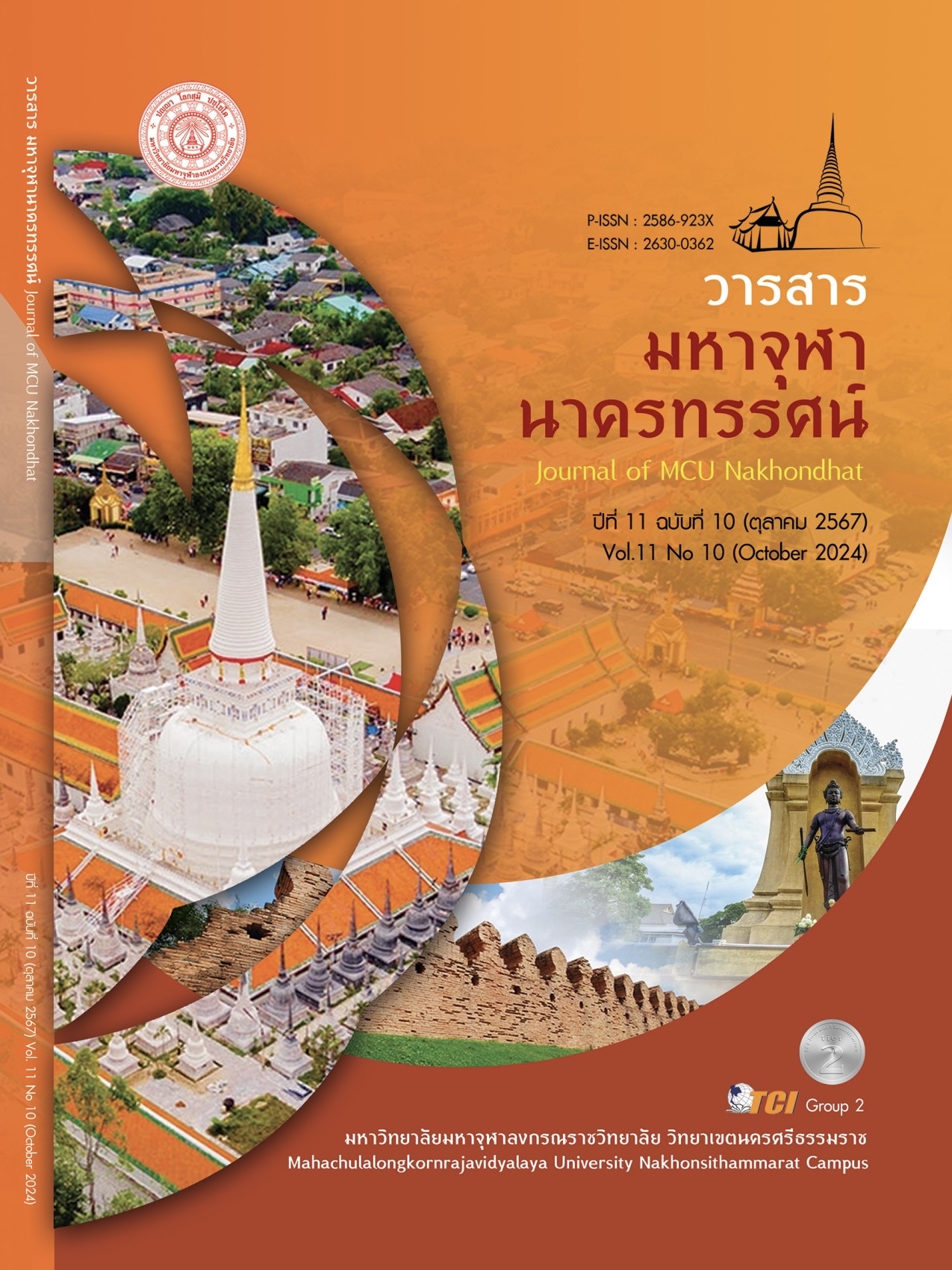A MODEL FOR PROMOTING AND PRESERVING THE WISDOM OF USING MEDICINAL PLANTS TO ENHANCEMAE KLA'S GRASSROOTS ECONOMY KHLONG HOI KHONG SUBDISTRICT KHLONG HOI KHONG DISTRICT, SONGKHLA PROVINCE
Main Article Content
Abstract
The objectives of this research article are to 1) Explore the general conditions, problems, obstacles, and needs for medicinal plants from local wisdom in order to raise the level of the grassroots economy in communities in Songkhla Province, 2) To promote the cultivation and production of medicinal plants with the participation of the community in order to improve the grassroots economy of Ban Mae Kla. Khlong Hoi Khong Subdistrict Khlong Hoi Khong District, Songkhla Province and 3) To present a model for promoting the conservation of wisdom, use, and cultivation of medicinal plants to enhance the grassroots economy in Songkhla Province. This qualitative research used in-depth interviews with 25 people. Key informants include Government representative groups such as district agriculture, subdistrict agriculture, herbal expert groups, folk philosophers, Subdistrict doctors, local doctors, groups of herbal growers, and groups of people who bring herbs to use. Data analysis techniques were used inductively and presented descriptively. The research results found that 1) The general condition of the Ban Mae Kla community The area is ready to grow medicinal plants. But rubber cultivation is the main occupation of farmers. 2) Promote the cultivation and production of medicinal plants. The planting area has been increased with community participation. There are enough herbs to enter the production system. Wat Prang Kaew is the main leader in driving the promotion of planting. Create an herbal breeding bed within the temple and distribute the plants. and 3) A model for promoting the conservation of wisdom, use, and cultivation of medicinal plants to enhance the grassroots economy in Songkhla Province. Applying the principles of a sufficiency economy, herbs can make money and be self-reliant. Take on the role of community leader by making it visible from the upstream steps. Midstream and downstream. To summarize for children and grandchildren to inherit wisdom in the future.
Article Details

This work is licensed under a Creative Commons Attribution-NonCommercial-NoDerivatives 4.0 International License.
References
กรมพัฒนาชุมชน. (2566). การพัฒนาเศรษฐกิจฐานราก เพื่อยกระดับคุณภาพชีวิตและลดความเหลื่อมล้ำของชุมชนอย่างยั่งยืน. เรียกใช้เมื่อ 4 มีนาคม 2567 จาก https://www.thailandplus.tv/archives/704490
คณะกรรมาธิการวิสามัญศึกษาแนวทางการพลิกโฉมพืชสมุนไพรไทยด้วยการวิจัยและนวัตกรรม วุฒิสภา. (2566). แนวทางการพลิกโฉมพืชสมุนไพรไทยด้วยการวิจัยและนวัตกรรม. เรียกใช้เมื่อ 30 มีนาคม 2567 จาก https://dl.parliament.go.th/handle/20.500.13072/614453
จุฑาธิป นัสฐาน และคณะ. (2567). การบริหารจัดการกลุ่มภายใต้ปรัชญาเศรษฐกิจพอเพียงของศูนย์การเรียนรู้ บ้านสมุนไพรบ้านคีรีวง อำเภอลานสกา จังหวัดนครศรีธรรมราช. วารสารนวัตกรรมเพื่อการพัฒนาสังคมที่ยั่งยืน, 3(1), 25-31.
ฉัตรชัย รุ่งจิรารัตน์ และคณะ. (2566). การอนุรักษ์ภูมิปัญญาท้องถิ่นเหยียบฉ่า วัดเกาะหงส์ อำเภอเมือง จังหวัดนครสวรรค์บนฐานการมีส่วนร่วม. วารสารวิจัยและวิชาการบวรพัฒน์, 1(1), 3-4.
ณัฐนนท์ จิรกิจนิมิต และคณะ. (2566). สัมมาชีพ: องค์ความรู้พืชสมุนไพรพื้นถิ่นและการจัดการเชิงเครือข่ายเพื่อการพัฒนาที่ยั่งยืนในพื้นที่ดอยลังกา. วารสารสันติศึกษาปริทรรศน์ มจร, 11(4), 1549-1561.
บุคคลที่ 1. (19 มีนาคม 2567). รูปแบบการส่งเสริมและอนุรักษ์ภูมิปัญญาการใช้ประโยชน์และการปลูกพืชสมุนไพรเพื่อยกระดับเศรษฐกิจฐานรากในจังหวัดสงขลา. (พระครูสิทธิสุตากร, ผู้สัมภาษณ์)
บุคคลที่ 10. (2 พฤษภาคม 2567). รูปแบบการส่งเสริมและอนุรักษ์ภูมิปัญญาการใช้ประโยชน์และการปลูกพืชสมุนไพร เพื่อยกระดับเศรษฐกิจฐานรากในจังหวัดสงขลา. (นายประสิทธิ์ รักนุ้ย, ผู้สัมภาษณ์)
บุคคลที่ 17. (2 พฤษภาคม 2567). รูปแบบการส่งเสริมและอนุรักษ์ภูมิปัญญาการใช้ประโยชน์และการปลูกพืชสมุนไพรเพื่อยกระดับเศรษฐกิจฐานรากในจังหวัดสงขลา. (นางสาววนิดา เหมือนจันทร์, ผู้สัมภาษณ์)
บุคคลที่ 20. (1 มิถุนายน 2567). รูปแบบการส่งเสริมและอนุรักษ์ภูมิปัญญาการใช้ประโยชน์และการปลูกพืชสมุนไพรเพื่อยกระดับเศรษฐกิจฐานรากในจังหวัดสงขลา. (นางสาววนิดา เหมือนจันทร์, ผู้สัมภาษณ์)
บุคคลที่ 3. (19 มีนาคม 2567). รูปแบบการส่งเสริมและอนุรักษ์ภูมิปัญญาการใช้ประโยชน์และการปลูกพืชสมุนไพรเพื่อยกระดับเศรษฐกิจฐานรากในจังหวัดสงขลา. (พระครูสิทธิสุตากร, ผู้สัมภาษณ์)
บุคคลที่ 7. (19 มีนาคม 2567). รูปแบบการส่งเสริมและอนุรักษ์ภูมิปัญญาการใช้ประโยชน์และการปลูกพืชสมุนไพรเพื่อยกระดับเศรษฐกิจฐานรากในจังหวัดสงขลา. (พระครูสิทธิสุตากร, ผู้สัมภาษณ์)
บุคคลที่ 9. (2 พฤษภาคม 2567). รูปแบบการส่งเสริมและอนุรักษ์ภูมิปัญญาการใช้ประโยชน์และการปลูกพืชสมุนไพรเพื่อยกระดับเศรษฐกิจฐานรากในจังหวัดสงขลา. (พระครูสิทธิสุตากร, ผู้สัมภาษณ์)
ปิยะนุช เหลืองาม และอิศรารัตน์ มาขันพันธ์. (2566). การอนุรักษ์ภูมิปัญญาการใช้ประโยชน์พืชสมุนไพรท้องถิ่นบ้านนาป่าหนาด ตำบลเขาแก้ว อำเภอเชียงคาน จังหวัดเลย. วารสาร มจร.หริภุญชัยปริทรรศน์, 7(3), 73-87.
ภุชงค์ เสนานุช และคณะ. (2566). การศึกษาความคิดเห็นเกี่ยวกับนโยบายการพัฒนาเศรษฐกิจฐานรากเพื่อการพัฒนาอย่างยั่งยืน. เรียกใช้เมื่อ 14 กุมภาพันธ์ 2567 จาก https://www.sdgmove.com/2023/01/24/opinions-on-sustainable-grassroot-economic-development-policy/
มหาวิทยาลัยรังสิต. (2562). การพัฒนาสมุนไพรไทยสู่ตลาดโลก. เรียกใช้เมื่อ 10 มกราคม 2567 จาก https://www2.rsu.ac.th/sarnrangsit-online-detail/herb01
อัสฉรา นามไธสง และคณะ. (2566). การเพิ่มการใช้ประโยชน์พืชสมุนไพรท้องถิ่นเพื่อยกระดับเศรษฐกิจชุมชน: กรณีศึกษาบ้านหนองบัว ตำบลบึงทวาย อำเภอเต่างอย จังหวัดสกลนคร. วารสารวิจัยและพัฒนามหาวิทยาลัยราชภัฏเลย, 18(65), 83-94.


